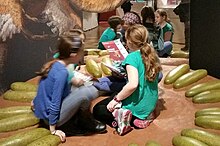Macroelongatoolithus
| Macroelongatoolithus | |
|---|---|

| |
| Macroelongatoolithus eggs in the Naturhistorisches Museum Wien
| |
| Egg fossil classification | |
| Basic shell type: | Ornithoid |
| Morphotype: | Ornithoid-ratite
|
| Oofamily: | †Elongatoolithidae |
| Oogenus: | †Macroelongatoolithus Li et al., 1995 |
| Synonyms | |
|
Oogenus synonymy | |
Macroelongatoolithus is an
History of discovery

"
Description

Macroelongatoolithus eggs are most notable for their large size. They are at least 34 centimetres (13 in) long, but the largest specimens are over 60 centimetres (24 in) long.
Like other elongatoolithids, Macroelongatoolithus's eggshell is divided up into two structural layers, and the outer layer (called the continuous layer) is not divided up into distinct shell units, unlike other oofamilies. In Macroelongatoolithus, the boundary between the continuous layer and the mammillary layer (the inner layer of the eggshell, also called the cone layer) is wavy, but clearly defined. The ratio of the thickness of the two layers varies from 2:1 to 8:1.[4][8]
The surface ornamentation of the eggshells is variable, even on a single egg. It is usually lineartuberculate (nodes forming linear ridges), ramotuberculate (nodes forming irregular, meandering chains), or dispersituberculate (scattered nodes).[4][8]
Macroelongatoolithus specimens are extremely variable in size, shape, and microstructure, even in eggs laid by a single individual. For example, within a single clutch, the egg lengths can vary by several centimeters. The high amount of variability is probably due to their large size.[5]
Classification
Macroelongatoolithus has a convoluted parataxonomic
Paleobiology

While they were once considered to be the eggs of large
The gas conductance of the eggshells indicate that Macroelongatoolithus nests were buried in vegetation or sediments. Like other elongatoolithids, Macroelongatoolithus eggs are laid in pairs because the parents had two functional oviducts and thus laid two eggs simultaneously. The nests have unusually large volume of eggs compared to the body size of the parents, which could mean that multiple females would contribute to a single nest. Association of other oviraptorids with their eggs suggests extensive parental care was typical for elongatoolithids.[4]

In 2018, Kohei Tanaka and team examined the
Paleoecology
Distribution
Macroelongatoolithus eggs have been found in the
The presence of Macroelongatoolithus in the United States indicates that there was likely a giant oviraptorosaur present during the Late Cretaceous in North America. Also, the fact that they have been found in both Asia and North America is evidence of an Albian-Cenomanian interchange of fauna between the two continents.[5][4][8]
See also
- List of dinosaur oogenera
- Elephant bird, the avian dinosaur that laid the largest egg.
References
- ^ Jensen J. 1970. Fossil eggs in the lower cretaceous of Utah. Brigham Young University research studies. Geology Series. Geology Studies 17: 51-65.
- ^ Bray, E. S. 1998. Dinosaur eggshell Boletuoolithus carlylensis, oogen. nov. from the Lower Cretaceous Cedar Mountain Formation of Utah; pp. 221–223 in S. G. Lucas, J. I. Kirkland, and J. W. Estep (eds.), Lower and Middle Cretaceous Terrestrial Ecosystems. New Mexico Museum of Natural History and Science Bulletin No. 14.
- ^ Li Y, Yin Z, Liu Y. (1995) "The discovery of a new genus of dinosaur egg from Xixia, Henan, China." Journal of Wuhan Institute of Chemical Technology 17(1): 38-41. (In Chinese)
- ^ a b c d e f g h i j k l m n Simon, D. J. (2014). "Giant Dinosaur (theropod) Eggs of the Oogenus Macroelongatoolithus (Elongatoolithidae) from Southeastern Idaho: Taxonomic, Paleobiogeographic, and Reproductive Implications" (PDF). Doctoral Dissertation, Montana State University. Bozeman. Archived (PDF) from the original on 11 August 2021.
- ^ a b c d e Zelenitsky DK, Carpenter K, Currie PJ. (2000) "First record of Elongatoolithid theropod eggshell from North America: the Asian oogenus Macroelongatoolithus from the lower Cretaceous of Utah." Journal of Vertebrate Paleontology 20(1): 130-138.
- ^ Carpenter, K. 1999. Eggs, Nests, and Baby Dinosaurs: A Look at Dinosaur Reproduction (Life of the Past). Indiana University Press, Bloomington, Indiana.
- ^ PMID 28486442.
- ^ S2CID 191155027.
- ^ Qian, M. P., Jiang, Y., Jiang, Y. G., Zhang, Y. J., Chen, R., Li, L. M., and Xing, G. F. (2008). "New evidence on fossil eggs of Cretaceous Tyrannosaurs in eastern China." Jiangsu Geology, 32: 86-97.
- ^ a b Grellet-Tinner, G., Chiappe, L., Norell, M., and Bottjer, D. (2006). "Dinosaur eggs and nesting behaviors: a paleobiological investigation." Palaeogeography, Palaeoclimatology, Palaeoecology, 232(2): 294-321.
- PMID 29769301.
- ISBN 978-0-8137-0011-3.)
{{cite book}}: CS1 maint: multiple names: authors list (link - ^ X. Jin, Y. Azuma, F. D. Jackson and D. J. Varricchio. (2007) "Giant dinosaur eggs from the Tiantai basin, Zhejiang province, China." Canadian Journal of Earth Sciences 44:81-88.
- ^ Wang Qiang, Zhao Zikui, Wang Xiaolin, Jiang Yangen, and Zhang Shukang. (2010) "A New Oogenus Of Macroelongatoolithid Eggs From The Upper Cretaceous Chichengshan Formation Of The Tiantai Basin, Zhejiang Province And A Revision Of The Macroelongatoolithids" Acta Paleontologica Sinica 49(1):73-86.
- ^ Li, G., Chen, P., Wang, D., & Batten, D. J. (2009). "The spinicaudatan Tylestheria and biostratigraphic significance for the age of dinosaur eggs in the Upper Cretaceous Majiacun Formation, Xixia Basin, Henan Province, China." Cretaceous Research, 30(2): 477-482.
- ^ Kim, J. Y., Yang, S. Y., Choi, H. I., Seo, S. J., & Kim, K. S. (2011). Dinosaur eggs from the Cretaceous Goseong formation of Tongyeong City, southern coast of Korea. Journal of the Paleontological Society of Korea 27(1): 13-26.
- ^ Huh, M., Kim, B. S., Woo, Y., Simon, D. J., Paik, I. S., & Kim, H. J. (2014). First record of a complete giant theropod egg clutch from Upper Cretaceous deposits, South Korea. Historical Biology, 26(2), 218–228. https://doi.org/10.1080/08912963.2014.894998
External links
 Media related to Macroelongatoolithus at Wikimedia Commons
Media related to Macroelongatoolithus at Wikimedia Commons Data related to Macroelongatoolithus at Wikispecies
Data related to Macroelongatoolithus at Wikispecies
